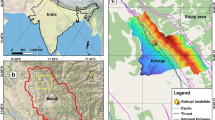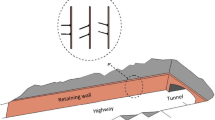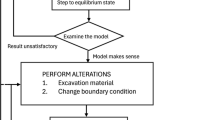Abstract
Most tailings storage facility (TSF) failures occur in active, upstream-type TSFs, often due to extreme and unexpected weather conditions—specifically, heavy rainfall and strong winds. This case study of a TSF in southern Arizona examines the use of the optimum safe beach distance (Doptimal, the optimum distance between the crest and decant pond) as a tool for monitoring geotechnical stability and reducing catastrophic failures. A digital model of the TSF was used to determine the critical beach distance (Dcritical) under normal weather conditions, and Doptimal was then determined by adding incremental distances to account for the effects of heavy rainfall (Drainfall) and strong winds (Dwind). To overcome accessibility issues, a drone was used to map the TSF geometry and create a digital model. This model served as the basis for conducting a coupled stress-seepage, finite-element (FEM) analysis with a safety factor of 2.0 to assess geotechnical stability (Dcritical). The safe beach distance increments were determined using the PMP (probable maximum precipitation) and possible maximum wind speed. Based on this analysis, the optimal safe beach distance at the study site was identified as 202.2 m. Since the current beach distance (371 m) exceeds this value, the TSF was considered to be stable and satisfied the design safety factor of 2.0. However, this distance should be reassessed periodically to account for changes in the TSF geometry and other conditions. Furthermore, it applies only TSFs that are well-managed and feature a smooth, non-undulating beach surface with a consistent slope.











Similar content being viewed by others
References
U.S. Committee on Large Dams (USCOLD) (2004) Tailings Dam Incidents, Denver, Colorado
United Nations Environmental Programme (UNEP) Division of Technology, Industry and Economics (DTIE) and International Commission on Large Dams (ICOLD) (2001) Tailings dams - risk of dangerous occurrences, lessons learnt from practical experiences. Bulletin 121, Paris
Rico M, Benito G, Salgueiro AR, Díez-Herrero A, Pereira HG (2008) Reported tailings dam failures-a review of the European incidents in the worldwide context. J Hazard Mater 152:846–852
Azam S, Li Q (2010) Tailings dam failures: a review of the last 100 years. Geotech.News:50–53
do Carmo FF, Kamino LHY, Junior RT, de Campos IC, do Carmo FF, Silvino G, Mauro ML, Rodrigues NUA, de Souza Miranda MP, Pinto CEF (2017) Fundão tailings dam failures: the environment tragedy of the largest technological disaster of Brazilian mining in global context. Perspectives in ecology and conservation 15(3):145–151
Force BMT (2000) Report of the international task force for assessing the Baia Mare accident. European Union, Baia Mare Task Force
Morgenstern NR, Vick SG, Viotti CB and Watts BD (2016) Fundão tailings dam review panel report on the immediate causes of the failure of the Fundão dam. SAMARCO, SA, Vale, SA, Eds, p76
Burritt RL, Christ KL (2018) Water risk in mining: analysis of the Samarco dam failure. J Clean Prod 178(2018):196–205
Vick SG (1983) Planning, design, and analysis of tailings dams. Wiley, New York
Martin TE, McRoberts EC (1999) Some considerations in the stability analysis of upstream tailings dams. In: Proc. tailings & mine waste’99, pp 287–302
Li W and Wang C (2011) GPS in the tailings dam deformation monitoring, in Proceedings of the 1st International Symposium on Mine Safety Science and Engineering (ISMSSE ’11), 26:1648–1657
Hu J, Hu S, Kang F, Zhang J (2013) Real-time dry beach length monitoring for tailings dams based on visual measurement. Math Probl Eng 2013:1–7
Yu G, Song C, Zou J et al. (2011) Applications of online monitoring technology for tailings dam on digital mine, Transactions of Nonferrous Metals Society of China, vol. 21, supplement 3, pp. s604–s609
Li Q, Wang Y, and Li G (2011) Tailings dam breach disaster online monitoring method and system realization, in Proceedings of the 1st International Symposium on Mine Safety Science and Engineering (ISMSSE ’11), 26:1674–1681
Sun E, Zhang X, Li Z (2012) The internet of things (IOT) and cloud computing (CC) based tailings dam monitoring and pre-alarm system in mines. Saf Sci 50(4):811–815
Kossoff D, Dubbin W, Alfredsson M, Edwards S, Macklin M, Hudson-Edwards KA (2014) Mine tailings dams: characteristics, failure, environmental impacts, and remediation. Appl Geochem 51:229–245
Mine Safety and Health Administration (MSHA) (2009) MSHA metal and nonmetal tailings and water impoundment inspection form(PIL I13-IV-1), Arlington, Virginia
The mining association of Canada (2013) A guide to the management of tailings facilities. Ottawa, Ontario
DITR, (2007) Lpsd: tailings management. Department of Industry, Tourism, and Resources, Canberra Australia
Roger Knutsson (2018) Dissertation: on the behaviour of tailings dams management in cold regions, Luleå University of Technology Department of Civil, Environmental and Natural Resources Engineering Division of Mining and Geotechnical Engineering
McLellan BC, Corder GD, Giurco D, Green S (2009) Incorporating sustainable development in the design of mineral processing operations–review and analysis of current approaches. J Clean Prod 17(16):1414–1425
Rockscience website (2018) Various site pages: https://www.rocscience.com/rocscience/products/rs2. Accessed 11 May 2018
Swain RE, England JF, Bullard KL, and Raff DA (2006) Guidelines for evaluating hydrologic hazards, US Department of the Interior, Bureau of Reclamation
Harris (1963) Characteristics of the hurricane storm surge, US Department of the Commerce, National Oceanic and Atmospheric Administration
Hsu SA, Grymes JM, Yan Z (1997) A simplified hydrodynamic formula for estimating the wind-driven flooding in the lake Pontchartrain-Amite river basin. Nat’l Weather Digest 21(4):18–22
Chiu W.K., Ong W.H., Kuen, T., Courtney F. (2017) Large structures monitoring using unmanned aerial vehicles. Procedia Eng 2017, 188, 415–423
Szeliski R (2011) Computer vision: algorithms and applications, Texts in Computer Science. Springer, London
Agisoft Website (2016) Various site pages. http://www.agisoft.com/features/professional-edition. Accessed 17 August 2016
Arizona Department of Water Resources (2018) Groundwater Site Inventory, http://gisweb.azwater.gov/waterresourcedata/. Accessed 02 October 2018
Arizona Department of Water Resources (2013) Probable Maximum Precipitation Study for Arizona, Phoenix, Arizona
Hansen EM, Schreiner LC, and Miller JF (1982) Application of probable maximum precipitation estimates, United States east of the 105th meridian. Hydrometeorological Report No. 52, National Weather Service, National Oceanic and Atmospheric Administration, Silver Springs, MD
U. S. Army Corps of Engineers (USACE) (1977) Shore protection manual, 3rd edn. U.S. Government Printing Office, Washington
The Australian National Committee on Large Dams Incorporated (2012) Guidelines on tailings dam design, construction, operation and closure, Tasmania
Department of Commerce, National Oceanic & Atmospheric Administration, National Weather Service (2016) National Weather Service Instruction 10-1605, USA
Visethrattana K, Nantasin P, Udomchoke V and Sricharoen L (2008) Hydraulic conductivity properties of residual soil for slope stability analy-sis at Huai pin watershed, Nan Province
Author information
Authors and Affiliations
Corresponding author
Ethics declarations
Conflict of Interest
The authors declare that they have no conflicts of interest.
Additional information
Publisher’s Note
Springer Nature remains neutral with regard to jurisdictional claims in published maps and institutional affiliations.
Rights and permissions
About this article
Cite this article
Jeong, Y., Kim, K. A Case Study: Determination of the Optimal Tailings Beach Distance as a Guideline for Safe Water Management in an Upstream TSF. Mining, Metallurgy & Exploration 37, 141–151 (2020). https://doi.org/10.1007/s42461-019-00121-8
Received:
Accepted:
Published:
Issue Date:
DOI: https://doi.org/10.1007/s42461-019-00121-8




